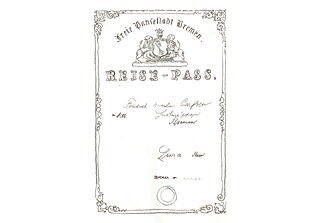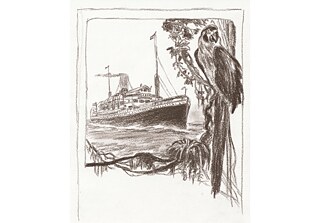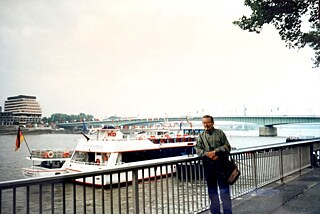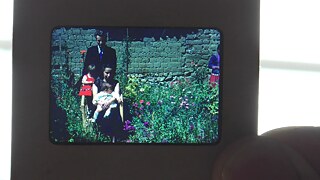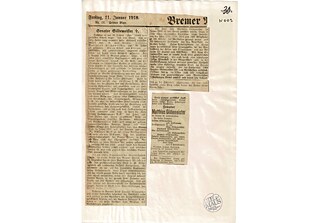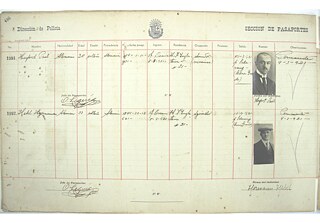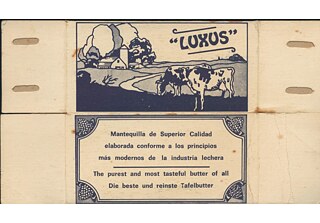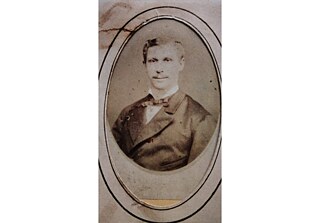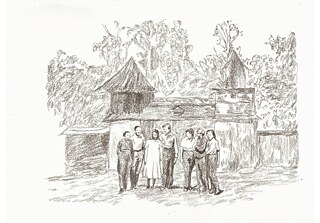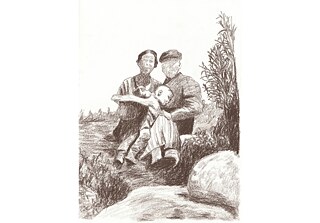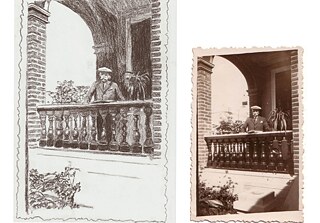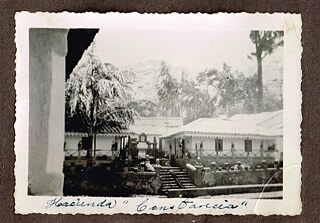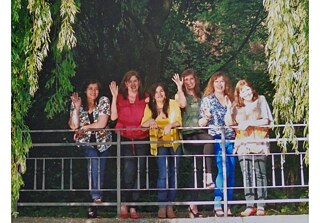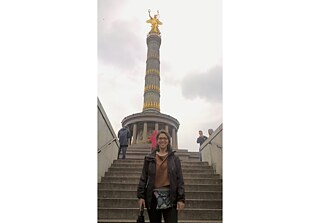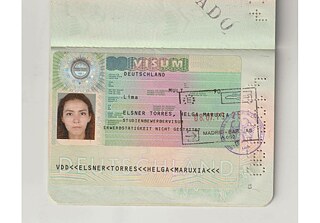Is there a connection between the migratory movement of Peruvians to Germany and the historical consequences of the German colonial structures in Peru? What motivated my great-grandfather Otto Elsner to migrate to this country? Were there other Germans living in Peru around 1925 or in the time leading up to it? What were their lives like?
By Helga Elsner Torres
I set myself the task of questioning the typical approaches to recording history in the past and present, with the help of family research and by compiling archive material belonging to Peruvians of German origin currently living in Berlin.
Drawing, German passport for the Bremen-Lima voyage. | © Helga Elsner Torres
The German migrants started to arrive in Peru from the mid-19th century onwards. In the first half of the 20th century their number increased significantly. At that time it was possible to travel to Peru by two routes. The first was via Bremen. Because of the high number of migrants embarking on this journey when they relaxed entry conditions for German citizens, Peru established several new ports to make arrival from Bremen easier.
Drawing, inspired by a poster advertising the Hamburg to Brazil route operated by the Hamburg-Südamerikanische Dampfschifffahrts-Gesellschaft (Hamburg South American steam shipping company) dating from 1910 | © Helga Elsner Torres
The second route was via Hamburg. After stopovers in Brazil, Cape Horn and Chile, the ship finally arrived in Peru. The advertising posters were colourful and generally portrayed South America as an exotic location with incredible natural diversity and countless undiscovered treasures.
Otto Elsner – a Peruvian with German roots - in Cologne, during his journey to Germany. | © Elsner family
The project Wo kommst du (eigentlich) her? (Where do you (really) come from?) has its origins in the compilation of archives and family documents. In 1996, my grandfather, the son of a German, travelled to Europe for the first time: with a Peruvian passport and a tourist visa.
Photographic slide dating from 1956. Family register in Huaraz, capital of the Ancash region and main residence of my grandfather Otto Elsner. Photographer unknown. | © Elsner family
During the course of the project, not only were family photos exchanged, but also stories and anecdotes about migration – as well as documents, letters and many other material objects and reflections that allow us to piece together the history of our ancestors.
Obituary from the Bremer Tageblatt dated 1918, in which the Gildemeisters’ commercial activities in Peru and Chile are mentioned. | © Die MAUS Bremen: Gesellschaft für Familienforschung e. V.
Even if Peru wasn’t officially a German colony, the country was dominated by colonial structures, which meant the Germans benefitted from direct and preferential contact with the political elite of that time in the country. This was the experience of many German traders, who were able to increase their capital and therefore their investments rapidly by exporting raw materials and local products, acquiring huge areas of land - especially on the central coast and in the north of Peru as well the rainforest - and accumulating property in order to subsequently establish powerful and influential corporations. This was also the case for the Gildemeister family from Bremen, who achieved wealth by exporting and selling saltpetre, and because of sugar production.
Home of a German labourer in the 3 de octubre district near the Casa Grande hacienda belonging to the Gildemeister family, Peru | © Helga Elsner Torres
When the business was flourishing, this family was bringing an increasing number of German workers to Peru, for example people to perform administrative roles or agricultural work. Most of them were accommodated on the extensive Casa Grande estate in the north of the country.
Migration register of Germans in Peru, with dates of entry and details of the ports through which they arrived. Here: information on Hermann Hebel, a colleague of Otto Elsner on the Hacienda Barbacay. | © Archivo General de la Nación, Peru
Their production facilities, known as haciendas, were clustered along the wide and extremely fertile north coast and in the centre of Peru. One of them was the Hacienda Barbacay in Huarmey, where my great-grandfather found a job.
“Luxus” branded butter, manufactured on the Hacienda Constancia. Package labelling in Spanish, English and German. | © Patricia Wieland Conroy
In the context of this research and based on the exchange of available information, it quickly becomes clear that the German migrants in Peru enjoyed many privileges. The Peruvian government pledged to give some immigrants land if they decided in favour of Peru – a promise that wasn’t always honoured. The richer ones were soon in possession of their own haciendas and private ports for their export trading. Yet others became farmers and supplied the rest of the Germans with items that were virtually unavailable or could be obtained only with difficulty in their homeland, for instance pottery or fabrics, such as the textiles of the pre-Columbian fardos funerarios , corpses swaddled in fabric and decorated with burial objects, also known as mummy bundles.
Enrique Böttger, founder of Oxapampa and owner of a farmstead in the Chontabamba district. Photographer unknown. | © Janeth Schipper Böttger
Enrique Böttger, founder of Oxapampa and owner of a farmstead in the Chontabamba district, traded with the indigenous Amuesha people and exchanged goods brought over from Germany – such as mirrors – for paintings or practical knowledge to help them cultivate cassava. Enrique went to Peru with his brother Pablo, but the latter settled in Yanachaga. This location in the central rainforest region is still home to a fairly significant number of Peruvians with German roots to this day.
Drawing, inspired by a photo of the Böttger family on their estate in Yanachaga in the Huancabamba region, Central Peru. The original photo showed Pablo Böttger Treu, his wife Mina Nissen and their family. Photographer unknown. | © Helga Elsner Torres
What motivated the migrants to relocate to Peru? While some of them came from poor backgrounds and were hoping this step would help them achieve better future prospects, others managed to settle in Peru quickly and permanently. The deciding factor here was the wealth of natural resources available, the vast swathes of unpopulated land and the active support from the Peruvian government.
Drawing, inspired by a private photo in the possession of the Cossio Tidow family. Ulrich Tidow and his parents, Hans and Therese Tidow, in the countryside near Arequipa, in southern Peru. Hans Tidow worked in Günther & Tidow’s brewery. | © Helga Elsner Torres
Many German migrants officially only associated with other Germans. They married within select circles and their children were brought up by German standards. However some German men established parallel families with Peruvian women.
Ferdinand Wieland on the Hacienda “Constancia“, Huancavelica, in Central West Peru. | © Patricia Wieland Conroy
However, there have been occasional cases of German migrants entering into long-term relationships with Peruvians and establishing families with them.
Hacienda “Constancia“, Huancavelica, in Central West Peru. | © Patricia Wieland Conroy
Over the years, many subsequent generations grew up on the haciendas that belonged to those first migrants from Germany.
The six Schipper Böttger sisters on Prenzlauer Berg, Berlin | © Schipper Böttger family
Today, several decades later, many of those descendants have decided to return to Germany. The reasons are always different, but the motivation is the same as it was originally: a search for new paths and opportunities. Easier access to university studies often plays a role, sometimes it can also simply be the desire to improve quality of life and live in a country that’s safer than Peru is nowadays.
Marlene Gildemeister in front of the Siegessäule (Victory Column) in Berlin | © Marlene Gildemeister
For this reason postcolonial migration can now be identified in Germany – once a colonial power and accumulator of wealth. This would be the obvious explanation for the current migration flows towards Europe.
German visa for Helga Elsner Torres | © Helga Elsner Torres
But are there really equal opportunities for Peruvian migrants in Germany? And is there a connection between the after-effects of colonial structures and the current migration movement between Germany and Peru? I will be looking at these questions and more at both an artistic level and a personal one. The results will be on display from 5th November 2021 in an exhibition in the KulturMarktHalle e.V. in Berlin.

